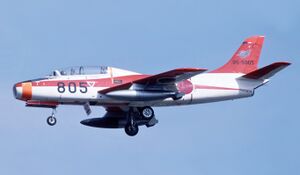Engineering:Fuji T-1
| T-1 | |
|---|---|

| |
| T-1B in special paint scheme | |
| Role | Intermediate trainer aircraft |
| Manufacturer | Fuji Heavy Industries |
| First flight | January 1, 1958 |
| Retired | March 3, 2006[citation needed] |
| Produced | 1962-1963 |
| Number built | 66 |
The Fuji T-1 was Japan 's first jet-powered trainer aircraft. Its first flight was in January 1958. A total of 66 T-1 planes were built.[1] It was retired in March 2006.[citation needed]
Design and development
After World War II, Japanese aircraft industry was banned from research as well as the destruction of materials and equipment related to aircraft. In 1952, a partial ban on aircraft research was lifted, making it possible to develop Japan's own domestic jet aircraft. In the spring of 1954, the Defense Agency's plan to develop a training jet aircraft emerged, which later lead to the development of the T-1 training plane.[2]
The T-1 was the first indigenously designed Japanese jet aircraft to be developed since World War II. It was Japan's first mass-produced jet and the first aircraft to apply a swept wing.[2] The development of a domestic jet engine was not completed in time, so the T-1A was powered by the British-designed Bristol Siddeley Orpheus turbojet[3] and made its first flight on May 17, 1960.[2] The T-1B was powered by the Ishikawajima-Harima J3 turbojet[4] and 20 were produced between June 1962 and June 1963.[2] Fuji was the successor to the Nakajima Aircraft Company (famous for building several aircraft such as Nakajima Ki-43 and Nakajima Ki-84 during WW2). The first aircraft of Fuji's own design was the T-1 jet trainer.[5][6]
More than 200 T-1s were to be produced, but with the introduction of the Lockheed F-104J/DJ fighters, the education system changed and the Lockheed T-33A, which was in large numbers, took on the same role, and only 66 T-1s were introduced.[2]
With the entry into service of its successor, the Kawasaki T-4, flight training with the T-1 was completed in December 2000. The last T-1 was retired on March 3, 2006.[citation needed]
Variants
Data from: Simpson 2001, p. 246
- T1F1
- One Prototype[citation needed] powered by a Nippon J3 engine.[7]
- T1F2
- Two prototypes, powered by 11,800 N (2,645 lbf) Bristol BOr.1 Orpheus engines.[7]
- T1F3
- Initial designation for the production T-1A, powered by 11,765.55 N (2,645 lbf) Bristol BOr.4 Orpheus engines.[7]
- T-1A
- Powered by a 17.79 kN (4,000 lbf) Bristol Siddeley Orpheus Mk 805 turbojet engine. The original designation was T1F3. 46 built.
- T-1B
- Powered by an 11.77 kN (2,645 lbf) Ishikawajima-Harima J3-IHI-3 turbojet engine. 20 built.[2]
- T-1C
- Converted to 13.72 kN (3,085 lbf) Ishikawajima-Harima J3-IHI-7 engines.
Operators
 Japan
Japan
- Japan Air Self Defense Force
Aircraft on display
- T-1B 25-5856 at Tokorozawa Aviation Museum, Saitama Prefecture
- T-1B 35-5870 at Saitama Subaru Sakitama Garden, Gyōda, Saitama Prefecture[8]
- T-1B 05-5810 at Kakamigahara Air and Space Museum
Specifications (T-1A)
Data from Jane's All The World's Aircraft 1965-66[9]
General characteristics
- Crew: 2
- Length: 12.12 m (39 ft 9 in)
- Wingspan: 10.50 m (34 ft 5 in)
- Height: 4.08 m (13 ft 5 in)
- Wing area: 22.22 m2 (239.2 sq ft)
- Aspect ratio: 4.96:1
- Airfoil: K-561/K-569
- Empty weight: 2,420 kg (5,335 lb)
- Gross weight: 4,150 kg (9,149 lb) clean
- Max takeoff weight: 5,000 kg (11,023 lb) (with external tanks)
- Fuel capacity: 1,400 L (308 Imp Gallons)
- Powerplant: 1 × Bristol Siddeley Orpheus Mk 805 turbojet, 18 kN (4,000 lbf) thrust
Performance
- Maximum speed: 925 km/h (575 mph, 499 kn) at 6,100 m (20,000 ft)
- Cruise speed: 620 km/h (390 mph, 330 kn) at 9,150 m (30,000 ft)
- Range: 1,300 km (810 mi, 700 nmi) (internal fuel)
- Ferry range: 1,950 km (1,210 mi, 1,050 nmi) (external tanks)
- Service ceiling: 14,400 m (47,200 ft) [10]
- Rate of climb: 33 m/s (6,500 ft/min)
- Thrust/weight: 0.43
Armament
- Guns: Provision for 1 × 12.7 mm Browning M53-2 machine gun in nose
- Hardpoints: 2 with provisions to carry combinations of:
- Missiles: 2 × AIM-9 Sidewinder air-to-air missiles
- Bombs: 2 × 750 lb (340 kg) bombs
- Other: 2 × 455 L (100 Imp Gallon) drop tanks
See also
Aircraft of comparable role, configuration and era
References
- Citations
- ↑ Simpson 2001, p.246
- ↑ 2.0 2.1 2.2 2.3 2.4 2.5 "日本の航空宇宙工業 50年の歩み 第2章 昭和30年代;再建の時期" (in ja). 一般社団法人日本航空宇宙工業会 (The Society of Japanese Aerospace Companies). pp. 17-19. https://www.sjac.or.jp/common/pdf/toukei/50nennoayumi/4_2_nihonnokoukuki2.pdf.
- ↑ "[3.0 Naval Sabres & Foreign Sabres"]. http://www.faqs.org/docs/air/avf863.html#m6.
- ↑ Odagiri, Hiroyuki (1996). Technology and Industrial Development in Japan. Clarendon Press, Oxford. pp. 224. ISBN 0-19-828802-6.
- ↑ "Archives at Flightglobal.com". http://www.flightglobal.com/pdfarchive/view/1962/1962%20-%201245.html.
- ↑ International, Flight (1962). Flight International. Delaney Gallay, LTD.
- ↑ 7.0 7.1 7.2 Bridgman, Leonard, ed (1958). Jane's All the World's Aircraft 1958-59. London: Jane's All the World's Aircraft Publishing Co. Ltd.. pp. 200-201.
- ↑ Thompson, Paul J-HangarSpace - Aviation Museums Retrieved September 8, 2016
- ↑ Taylor 1965, p. 103.
- ↑ Donald and Lake 1996, p.175.
- Bibliography
- Donald, David and Jon Lake. Encyclopedia of World Military Aircraft. London:Aerospace Publishing, 1996, Single Volume Edition. ISBN:1-874023-95-6.
- Simpson, Rod (2001). Airlife's World Aircraft. Shrewsbury: Airlife Publishing Ltd. ISBN 9781840371154.
- Taylor, John W. R. Jane's All The World's Aircraft 1965-66. London:Sampson Low, Marston, 1965.
External links
 |




